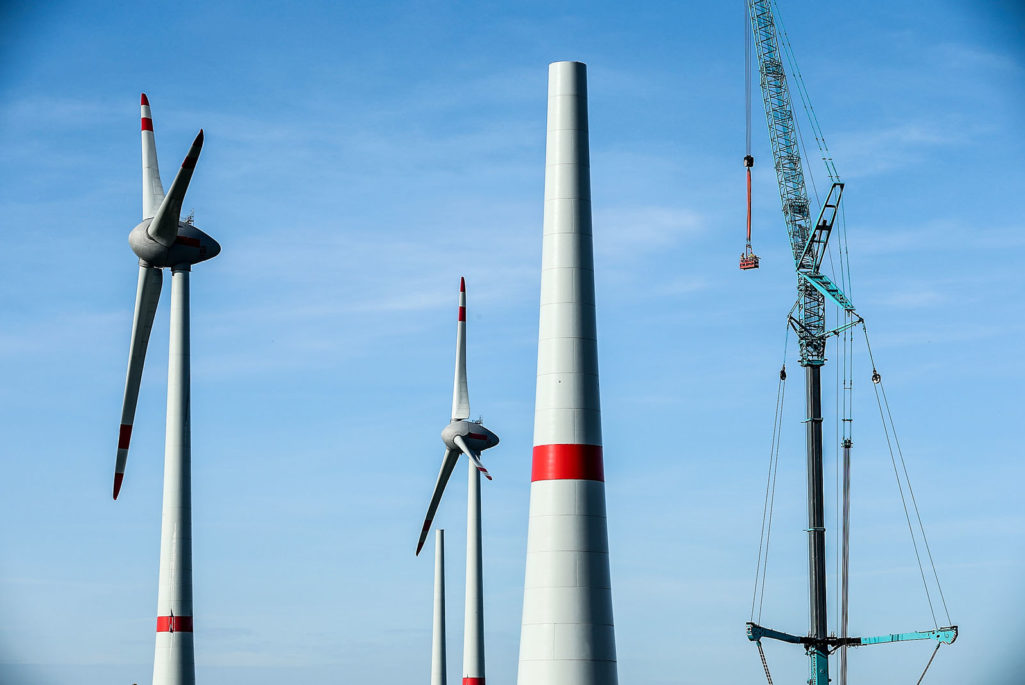Spending More to Make Infrastructure Sustainable

Workers standing in a basket hang from a crane next to a wind turbine under construction at the Werder/Kassin RH2-WKA windpark near Grapzow, Germany.
Photo: Sean Gallup/Getty Images
“We’ll always have Paris.” On the same day that the Paris Agreement went into force, delegates attending a warm-up event in Casablanca, Morocco, before this year’s UN climate talks in Marrakesh, might have uttered that iconic line from the film Casablanca.
Yet, despite the location and timing being a perfect match, the Casablanca reference is off-key. As the film depicts, the protagonists may have found love in Paris, but their predicament dictated they must separate. In the case of the Paris Agreement—and its alignment with the finance necessary to implement it—this is not the end, but the start of what could be a beautiful friendship.
The Paris Agreement has the objective of making finance flows consistent with a pathway toward low emission and climate-resilient development. As countries look to boost growth while implementing the Sustainable Development Goals and their Paris commitments, shifting finance flows to sustainable infrastructure is critical.
This requires major investment in clean public transport, smart efficient energy systems and buildings and the effective use of natural capital such as forests. Studies show that such investments could increase upfront capital costs by approximately 5 percent, but sustainable infrastructure should generate lower operating costs over the life of the investment, while also reducing risks and negative externalities, including pollution.
The Global Commission on the Economy and Climate estimates that the world is expected to invest roughly $90 trillion in infrastructure over the next 15 years, a major boost from current levels. Most countries have chronic infrastructure deficits. In the case of Latin America and the Caribbean, the Inter-American Development Bank estimates that up to 5 percent of the region’s GDP, or roughly $250 billion per year, will be required to meet future demand for infrastructure.
In part, this deficit reflects existing barriers facing private sector financing of sustainable infrastructure. These include a failure on the part of governments to develop transparent pipelines, which has led to a poor estimation of infrastructure needs. Investors may also be deterred by high development and transactions costs.
The world is expected to invest $90 trillion in infrastructure over the next 15 years, far above current levels.
Fortunately, a large number of initiatives focused on closing the infrastructure funding gap are emerging.
The initiatives generally fall into three categories. One set are “influencers,” which focus on thought leadership and attempts to affect policy change. There are also “mobilizers,” which work to develop “bankable” projects or convene investors to facilitate capital flows. Lastly, “tool providers” attempt to enable integrated environmental or social analysis of infrastructure projects into the investment and monitoring process.
All of these industry initiatives have the potential to play significant roles in promoting investment in sustainable infrastructure; however, in some cases, they appear to be working against each other.
The Paris Agreement is lauded as helping to provide a long-term signal to investors to allocate capital that is consistent with low-carbon and resilient development. This signal can only illuminate the path forward; these initiatives must achieve far greater coherency and coordination between them to ensure that they and the Paris Agreement are mutually reinforcing.
Four Steps
To achieve this, we propose the following steps. First, industry initiatives need to clarify the principles and develop shared definitions for sustainable infrastructure investment. This can provide greater certainty and urgency across the industry and create a more compelling alternative to traditional infrastructure such as coal-fired power stations, while also enabling comparability for investors.
Second, those infrastructure initiatives that do not consider sustainable infrastructure should change tack and commit to sustainable infrastructure principles through a review of their mission and objectives.
Third, to optimize joint impact, it will be necessary to convene the conveners and work together towards a shared “grand plan” that sets out an effective division of labor and the sharing of ideas between initiatives.
Fourth, collaboration should be encouraged between initiatives sharing common missions so that collectively, they can work to scale-up investment
These steps will be essential to provide investors with the right signals and tools required to align their investment strategies with the Paris Agreement and Sustainable Development Goals.
Time is rapidly evaporating. With 70 percent of the forecast increase in emissions from developing countries likely to come from infrastructure that is still to be built, decisions taken now will determine whether staying well below 2 degrees Celsius is viable. The time to begin that beautiful friendship among sustainable infrastructure initiatives is now. Our future could very well depend on it.
This piece first appeared on the Thomson Reuters Foundation News.







